Chromatin Remodeling: Mechanisms, Functions, and Disease Associations
VerifiedAdded on 2022/08/26
|5
|1191
|22
Report
AI Summary
This report provides a comprehensive overview of chromatin remodeling, a critical process within eukaryotic cells. It begins with an introduction to chromatin, detailing its composition of DNA, histones, and RNA, and its role in packaging DNA within the nucleus. The report then elaborates on the mechanisms of chromatin remodeling, including the processes of wrapping and unwrapping DNA, and the formation of chromatin fibers, distinguishing between heterochromatin and euchromatin. It discusses the function of chromatin fibers in regulating gene expression through transcription and highlights the role of chromatin proteins in various cellular processes, such as DNA repair and pathogen resistance. The report also explores the association between abnormal chromatin regulation and various diseases, including Parkinson's syndrome, Fragile X syndrome, and Facioscapulo humeral muscular dystrophy. Finally, the report concludes by summarizing the key aspects of chromatin remodeling and its significance in cellular biology.
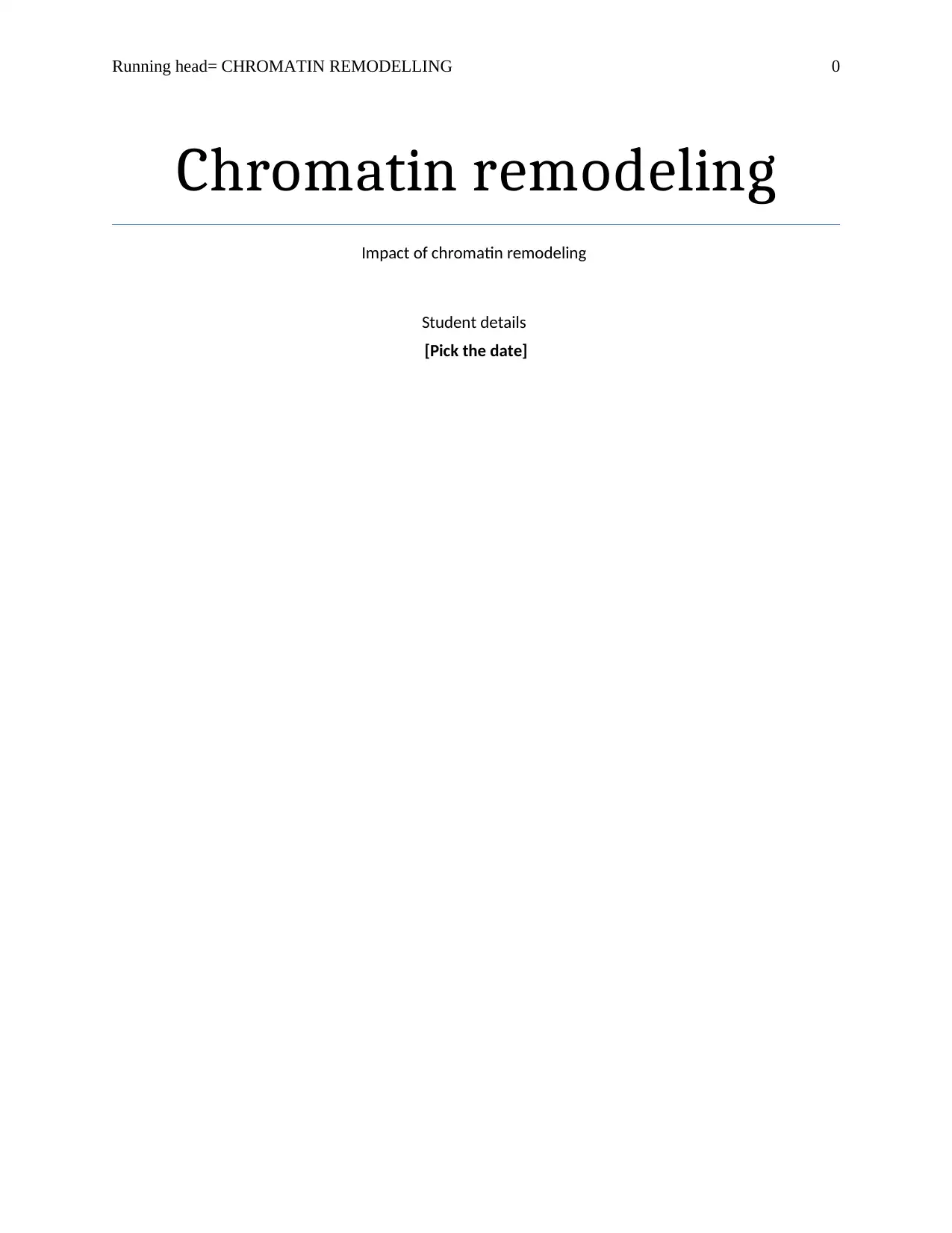
Running head= CHROMATIN REMODELLING 0
Chromatin remodeling
Impact of chromatin remodeling
Student details
[Pick the date]
Chromatin remodeling
Impact of chromatin remodeling
Student details
[Pick the date]
Paraphrase This Document
Need a fresh take? Get an instant paraphrase of this document with our AI Paraphraser
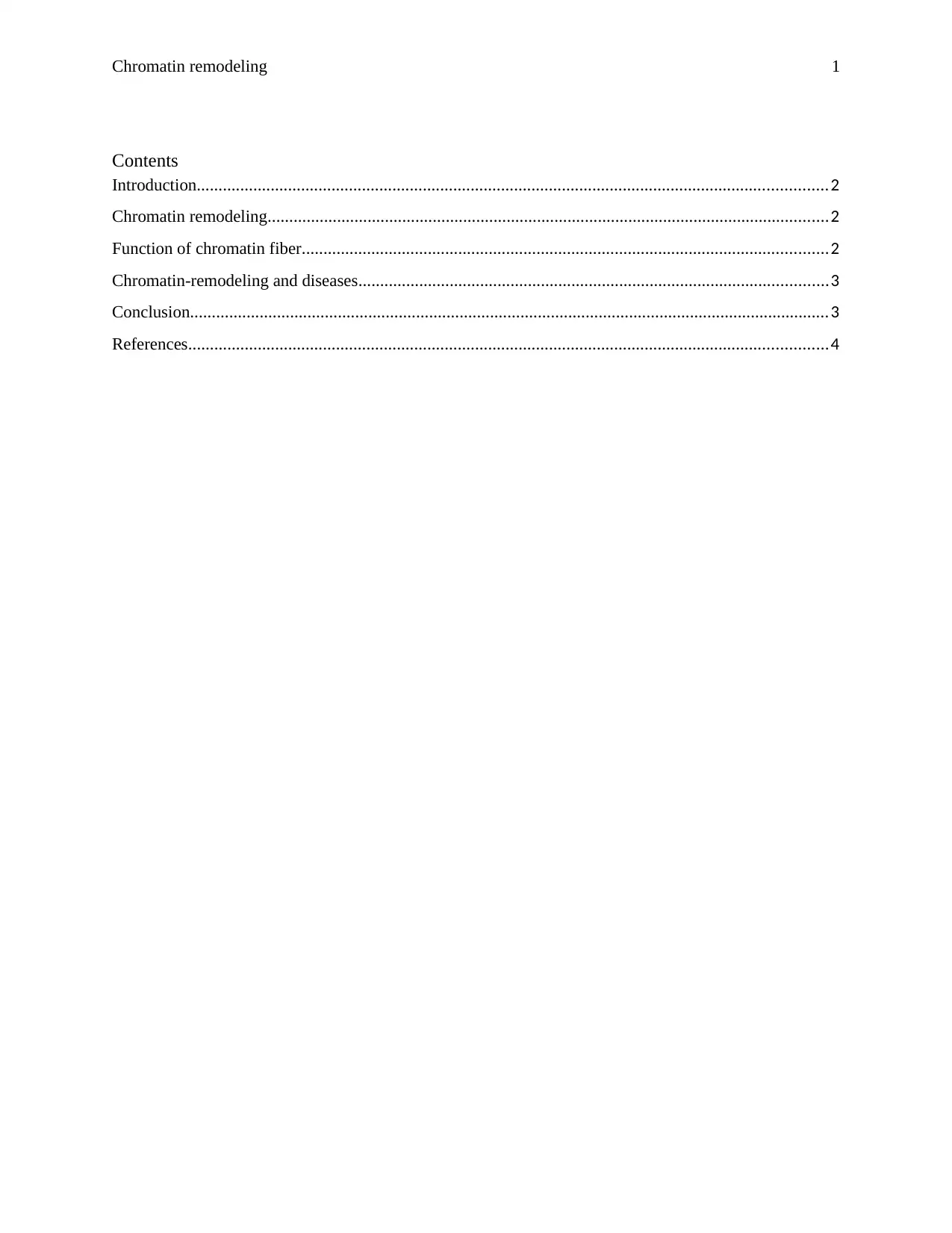
Chromatin remodeling 1
Contents
Introduction.................................................................................................................................................2
Chromatin remodeling.................................................................................................................................2
Function of chromatin fiber.........................................................................................................................2
Chromatin-remodeling and diseases............................................................................................................3
Conclusion...................................................................................................................................................3
References...................................................................................................................................................4
Contents
Introduction.................................................................................................................................................2
Chromatin remodeling.................................................................................................................................2
Function of chromatin fiber.........................................................................................................................2
Chromatin-remodeling and diseases............................................................................................................3
Conclusion...................................................................................................................................................3
References...................................................................................................................................................4
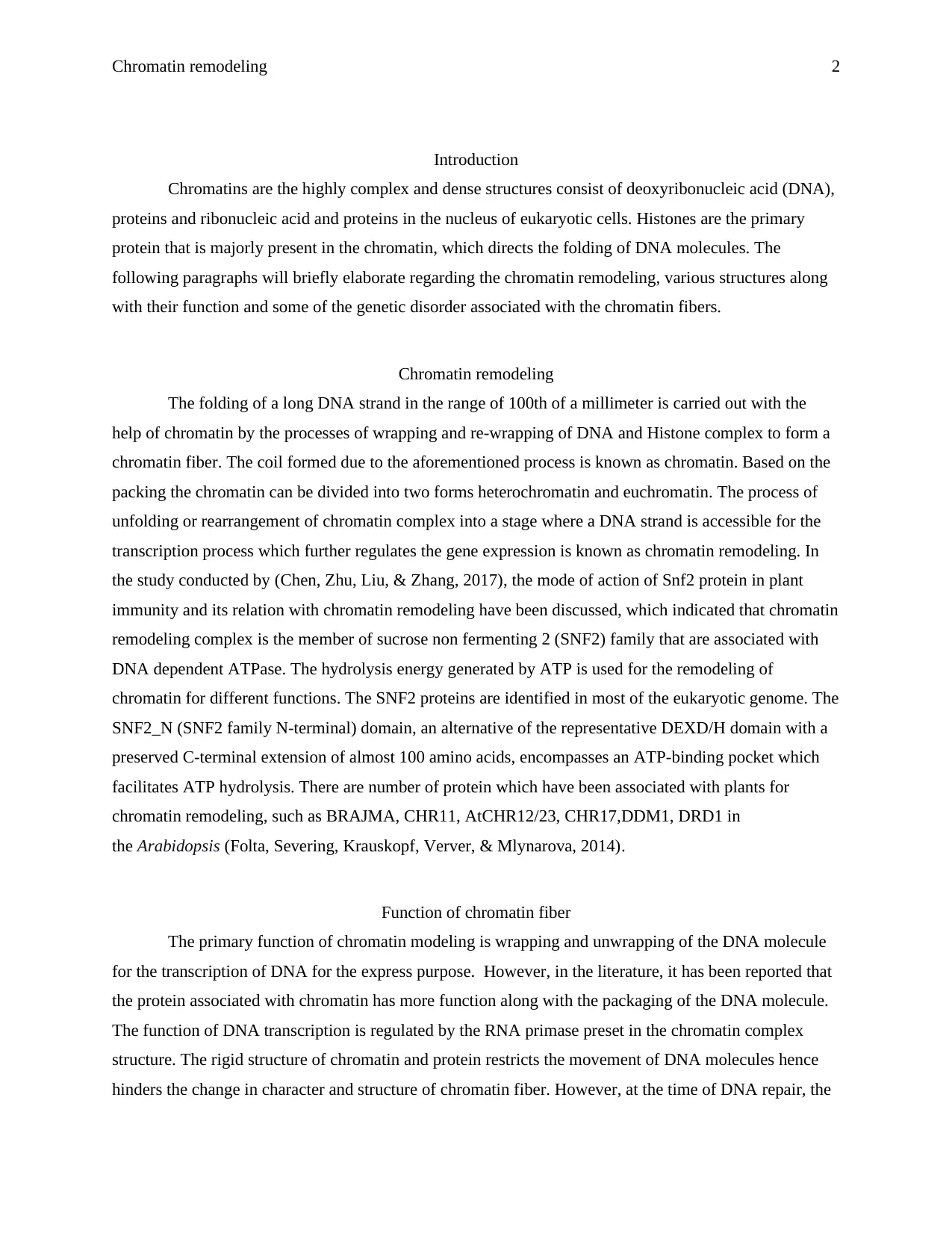
Chromatin remodeling 2
Introduction
Chromatins are the highly complex and dense structures consist of deoxyribonucleic acid (DNA),
proteins and ribonucleic acid and proteins in the nucleus of eukaryotic cells. Histones are the primary
protein that is majorly present in the chromatin, which directs the folding of DNA molecules. The
following paragraphs will briefly elaborate regarding the chromatin remodeling, various structures along
with their function and some of the genetic disorder associated with the chromatin fibers.
Chromatin remodeling
The folding of a long DNA strand in the range of 100th of a millimeter is carried out with the
help of chromatin by the processes of wrapping and re-wrapping of DNA and Histone complex to form a
chromatin fiber. The coil formed due to the aforementioned process is known as chromatin. Based on the
packing the chromatin can be divided into two forms heterochromatin and euchromatin. The process of
unfolding or rearrangement of chromatin complex into a stage where a DNA strand is accessible for the
transcription process which further regulates the gene expression is known as chromatin remodeling. In
the study conducted by (Chen, Zhu, Liu, & Zhang, 2017), the mode of action of Snf2 protein in plant
immunity and its relation with chromatin remodeling have been discussed, which indicated that chromatin
remodeling complex is the member of sucrose non fermenting 2 (SNF2) family that are associated with
DNA dependent ATPase. The hydrolysis energy generated by ATP is used for the remodeling of
chromatin for different functions. The SNF2 proteins are identified in most of the eukaryotic genome. The
SNF2_N (SNF2 family N-terminal) domain, an alternative of the representative DEXD/H domain with a
preserved C-terminal extension of almost 100 amino acids, encompasses an ATP-binding pocket which
facilitates ATP hydrolysis. There are number of protein which have been associated with plants for
chromatin remodeling, such as BRAJMA, CHR11, AtCHR12/23, CHR17,DDM1, DRD1 in
the Arabidopsis (Folta, Severing, Krauskopf, Verver, & Mlynarova, 2014).
Function of chromatin fiber
The primary function of chromatin modeling is wrapping and unwrapping of the DNA molecule
for the transcription of DNA for the express purpose. However, in the literature, it has been reported that
the protein associated with chromatin has more function along with the packaging of the DNA molecule.
The function of DNA transcription is regulated by the RNA primase preset in the chromatin complex
structure. The rigid structure of chromatin and protein restricts the movement of DNA molecules hence
hinders the change in character and structure of chromatin fiber. However, at the time of DNA repair, the
Introduction
Chromatins are the highly complex and dense structures consist of deoxyribonucleic acid (DNA),
proteins and ribonucleic acid and proteins in the nucleus of eukaryotic cells. Histones are the primary
protein that is majorly present in the chromatin, which directs the folding of DNA molecules. The
following paragraphs will briefly elaborate regarding the chromatin remodeling, various structures along
with their function and some of the genetic disorder associated with the chromatin fibers.
Chromatin remodeling
The folding of a long DNA strand in the range of 100th of a millimeter is carried out with the
help of chromatin by the processes of wrapping and re-wrapping of DNA and Histone complex to form a
chromatin fiber. The coil formed due to the aforementioned process is known as chromatin. Based on the
packing the chromatin can be divided into two forms heterochromatin and euchromatin. The process of
unfolding or rearrangement of chromatin complex into a stage where a DNA strand is accessible for the
transcription process which further regulates the gene expression is known as chromatin remodeling. In
the study conducted by (Chen, Zhu, Liu, & Zhang, 2017), the mode of action of Snf2 protein in plant
immunity and its relation with chromatin remodeling have been discussed, which indicated that chromatin
remodeling complex is the member of sucrose non fermenting 2 (SNF2) family that are associated with
DNA dependent ATPase. The hydrolysis energy generated by ATP is used for the remodeling of
chromatin for different functions. The SNF2 proteins are identified in most of the eukaryotic genome. The
SNF2_N (SNF2 family N-terminal) domain, an alternative of the representative DEXD/H domain with a
preserved C-terminal extension of almost 100 amino acids, encompasses an ATP-binding pocket which
facilitates ATP hydrolysis. There are number of protein which have been associated with plants for
chromatin remodeling, such as BRAJMA, CHR11, AtCHR12/23, CHR17,DDM1, DRD1 in
the Arabidopsis (Folta, Severing, Krauskopf, Verver, & Mlynarova, 2014).
Function of chromatin fiber
The primary function of chromatin modeling is wrapping and unwrapping of the DNA molecule
for the transcription of DNA for the express purpose. However, in the literature, it has been reported that
the protein associated with chromatin has more function along with the packaging of the DNA molecule.
The function of DNA transcription is regulated by the RNA primase preset in the chromatin complex
structure. The rigid structure of chromatin and protein restricts the movement of DNA molecules hence
hinders the change in character and structure of chromatin fiber. However, at the time of DNA repair, the
⊘ This is a preview!⊘
Do you want full access?
Subscribe today to unlock all pages.

Trusted by 1+ million students worldwide
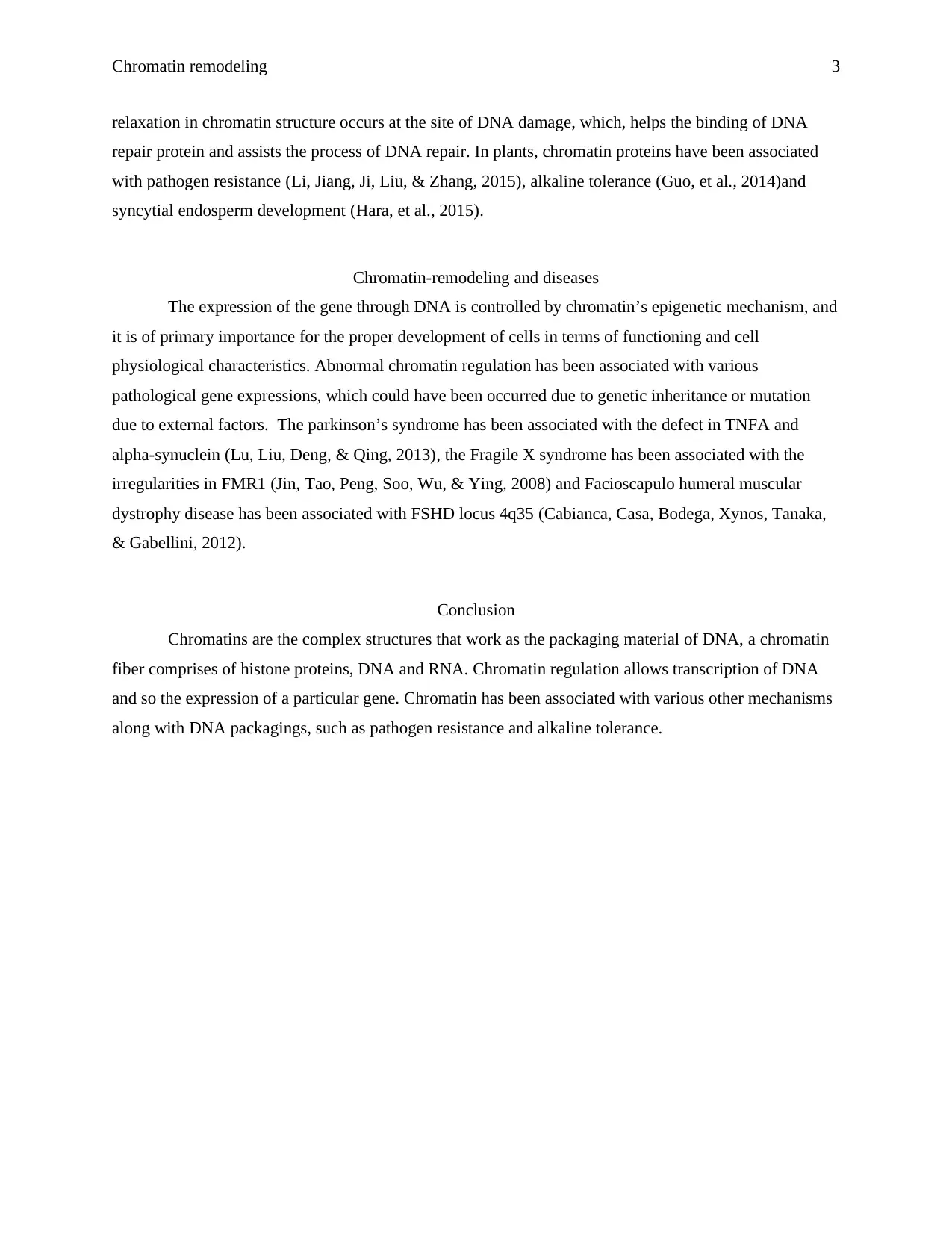
Chromatin remodeling 3
relaxation in chromatin structure occurs at the site of DNA damage, which, helps the binding of DNA
repair protein and assists the process of DNA repair. In plants, chromatin proteins have been associated
with pathogen resistance (Li, Jiang, Ji, Liu, & Zhang, 2015), alkaline tolerance (Guo, et al., 2014)and
syncytial endosperm development (Hara, et al., 2015).
Chromatin-remodeling and diseases
The expression of the gene through DNA is controlled by chromatin’s epigenetic mechanism, and
it is of primary importance for the proper development of cells in terms of functioning and cell
physiological characteristics. Abnormal chromatin regulation has been associated with various
pathological gene expressions, which could have been occurred due to genetic inheritance or mutation
due to external factors. The parkinson’s syndrome has been associated with the defect in TNFA and
alpha-synuclein (Lu, Liu, Deng, & Qing, 2013), the Fragile X syndrome has been associated with the
irregularities in FMR1 (Jin, Tao, Peng, Soo, Wu, & Ying, 2008) and Facioscapulo humeral muscular
dystrophy disease has been associated with FSHD locus 4q35 (Cabianca, Casa, Bodega, Xynos, Tanaka,
& Gabellini, 2012).
Conclusion
Chromatins are the complex structures that work as the packaging material of DNA, a chromatin
fiber comprises of histone proteins, DNA and RNA. Chromatin regulation allows transcription of DNA
and so the expression of a particular gene. Chromatin has been associated with various other mechanisms
along with DNA packagings, such as pathogen resistance and alkaline tolerance.
relaxation in chromatin structure occurs at the site of DNA damage, which, helps the binding of DNA
repair protein and assists the process of DNA repair. In plants, chromatin proteins have been associated
with pathogen resistance (Li, Jiang, Ji, Liu, & Zhang, 2015), alkaline tolerance (Guo, et al., 2014)and
syncytial endosperm development (Hara, et al., 2015).
Chromatin-remodeling and diseases
The expression of the gene through DNA is controlled by chromatin’s epigenetic mechanism, and
it is of primary importance for the proper development of cells in terms of functioning and cell
physiological characteristics. Abnormal chromatin regulation has been associated with various
pathological gene expressions, which could have been occurred due to genetic inheritance or mutation
due to external factors. The parkinson’s syndrome has been associated with the defect in TNFA and
alpha-synuclein (Lu, Liu, Deng, & Qing, 2013), the Fragile X syndrome has been associated with the
irregularities in FMR1 (Jin, Tao, Peng, Soo, Wu, & Ying, 2008) and Facioscapulo humeral muscular
dystrophy disease has been associated with FSHD locus 4q35 (Cabianca, Casa, Bodega, Xynos, Tanaka,
& Gabellini, 2012).
Conclusion
Chromatins are the complex structures that work as the packaging material of DNA, a chromatin
fiber comprises of histone proteins, DNA and RNA. Chromatin regulation allows transcription of DNA
and so the expression of a particular gene. Chromatin has been associated with various other mechanisms
along with DNA packagings, such as pathogen resistance and alkaline tolerance.
Paraphrase This Document
Need a fresh take? Get an instant paraphrase of this document with our AI Paraphraser
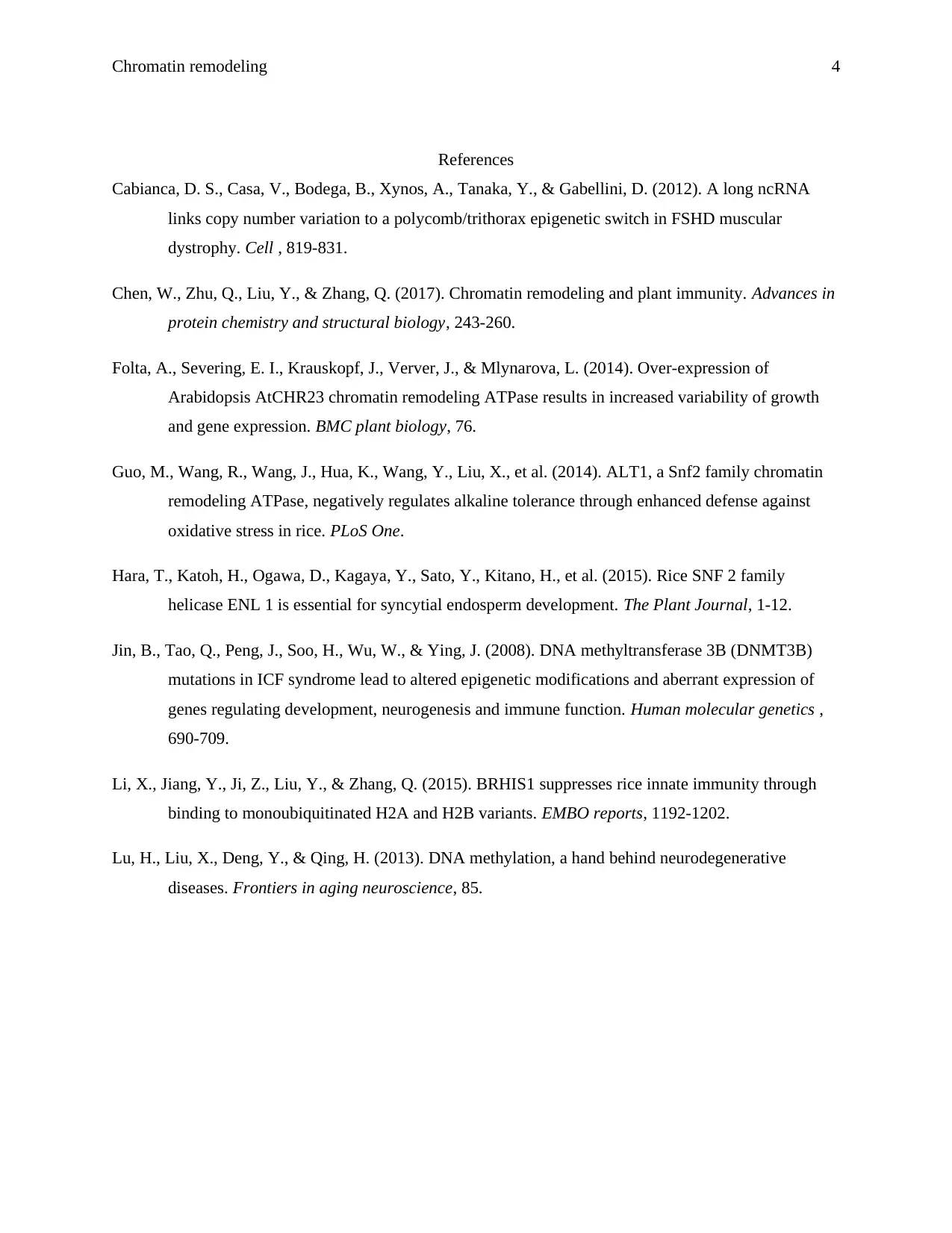
Chromatin remodeling 4
References
Cabianca, D. S., Casa, V., Bodega, B., Xynos, A., Tanaka, Y., & Gabellini, D. (2012). A long ncRNA
links copy number variation to a polycomb/trithorax epigenetic switch in FSHD muscular
dystrophy. Cell , 819-831.
Chen, W., Zhu, Q., Liu, Y., & Zhang, Q. (2017). Chromatin remodeling and plant immunity. Advances in
protein chemistry and structural biology, 243-260.
Folta, A., Severing, E. I., Krauskopf, J., Verver, J., & Mlynarova, L. (2014). Over-expression of
Arabidopsis AtCHR23 chromatin remodeling ATPase results in increased variability of growth
and gene expression. BMC plant biology, 76.
Guo, M., Wang, R., Wang, J., Hua, K., Wang, Y., Liu, X., et al. (2014). ALT1, a Snf2 family chromatin
remodeling ATPase, negatively regulates alkaline tolerance through enhanced defense against
oxidative stress in rice. PLoS One.
Hara, T., Katoh, H., Ogawa, D., Kagaya, Y., Sato, Y., Kitano, H., et al. (2015). Rice SNF 2 family
helicase ENL 1 is essential for syncytial endosperm development. The Plant Journal, 1-12.
Jin, B., Tao, Q., Peng, J., Soo, H., Wu, W., & Ying, J. (2008). DNA methyltransferase 3B (DNMT3B)
mutations in ICF syndrome lead to altered epigenetic modifications and aberrant expression of
genes regulating development, neurogenesis and immune function. Human molecular genetics ,
690-709.
Li, X., Jiang, Y., Ji, Z., Liu, Y., & Zhang, Q. (2015). BRHIS1 suppresses rice innate immunity through
binding to monoubiquitinated H2A and H2B variants. EMBO reports, 1192-1202.
Lu, H., Liu, X., Deng, Y., & Qing, H. (2013). DNA methylation, a hand behind neurodegenerative
diseases. Frontiers in aging neuroscience, 85.
References
Cabianca, D. S., Casa, V., Bodega, B., Xynos, A., Tanaka, Y., & Gabellini, D. (2012). A long ncRNA
links copy number variation to a polycomb/trithorax epigenetic switch in FSHD muscular
dystrophy. Cell , 819-831.
Chen, W., Zhu, Q., Liu, Y., & Zhang, Q. (2017). Chromatin remodeling and plant immunity. Advances in
protein chemistry and structural biology, 243-260.
Folta, A., Severing, E. I., Krauskopf, J., Verver, J., & Mlynarova, L. (2014). Over-expression of
Arabidopsis AtCHR23 chromatin remodeling ATPase results in increased variability of growth
and gene expression. BMC plant biology, 76.
Guo, M., Wang, R., Wang, J., Hua, K., Wang, Y., Liu, X., et al. (2014). ALT1, a Snf2 family chromatin
remodeling ATPase, negatively regulates alkaline tolerance through enhanced defense against
oxidative stress in rice. PLoS One.
Hara, T., Katoh, H., Ogawa, D., Kagaya, Y., Sato, Y., Kitano, H., et al. (2015). Rice SNF 2 family
helicase ENL 1 is essential for syncytial endosperm development. The Plant Journal, 1-12.
Jin, B., Tao, Q., Peng, J., Soo, H., Wu, W., & Ying, J. (2008). DNA methyltransferase 3B (DNMT3B)
mutations in ICF syndrome lead to altered epigenetic modifications and aberrant expression of
genes regulating development, neurogenesis and immune function. Human molecular genetics ,
690-709.
Li, X., Jiang, Y., Ji, Z., Liu, Y., & Zhang, Q. (2015). BRHIS1 suppresses rice innate immunity through
binding to monoubiquitinated H2A and H2B variants. EMBO reports, 1192-1202.
Lu, H., Liu, X., Deng, Y., & Qing, H. (2013). DNA methylation, a hand behind neurodegenerative
diseases. Frontiers in aging neuroscience, 85.
1 out of 5
Related Documents
Your All-in-One AI-Powered Toolkit for Academic Success.
+13062052269
info@desklib.com
Available 24*7 on WhatsApp / Email
![[object Object]](/_next/static/media/star-bottom.7253800d.svg)
Unlock your academic potential
Copyright © 2020–2025 A2Z Services. All Rights Reserved. Developed and managed by ZUCOL.





